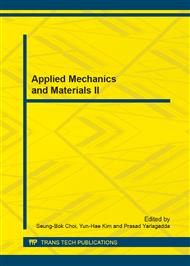p.105
p.109
p.114
p.119
p.123
p.128
p.132
p.137
p.141
Oscillation Suppression in a Delay-Coupled Flexible-Joint System
Abstract:
A delay-coupled flexible-joint system is investigated in this paper. Because of the different time scales, the flexible-joint system could be transformed into a fast subsystem and a slow subsystem. The geometric singular perturbation method is used to obtain the slow manifold defining as the equilibrium of the fast subsystem. The eigenvalue analysis of the fast subsystem reveals a relation between the stability of the slow manifold and the time delay. The analysis results provide an idea of suppressing the small amplitude periodic oscillation via adjusting the time delay. Numerical simulations are performed to display the effectiveness of this method.
Info:
Periodical:
Pages:
123-127
Citation:
Online since:
December 2013
Authors:
Price:
Сopyright:
© 2014 Trans Tech Publications Ltd. All Rights Reserved
Share:
Citation:


